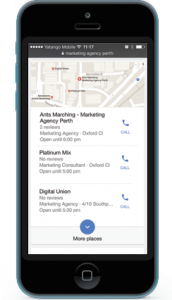Mobile Marketing
In this edition I would like to analyze what is mobile marketing, and how can help businesses to increase more visitor, or customers.
In 2016 the number of smartphone is estimated to be more than 2 billion worldwide, meaning that more than a quarter of the earth population will use a smartphone.
The advent of mobile technologies in the last decade, has introduced the localization concept. All the major players, Google at first, have developed platforms for local marketing, and Mobile Marketing like Google Places used together with Google Maps.
Location Based Mobile Marketing
To determine the position of a mobile device, search engines uses the smartphone IP address given by mobile providers, or by a wireless station.
This determines with a good accuracy the position of a user. The results of a search, are then sorted by proximity. The following screenshot shows how a local search would be displayed on a mobile device.
GPS localization is not always used, as it uses a lot of power when turned on.
This enables marketing companies to target customers based not only on the user preferences, but also on the position at the moment of the search request. This is what is called Local Search.
As a result, Search Engines, uses all the keyword used in the search bar, to make statistics not only on the search queries, but also on the position from which the queries has been made.
For marketers, this is an important indicator that can help predict the number of searches for a product, company or service.
Technologies
Location based marketing can’t interact with devices. In 2013 Apple introduced a technology called iBeacon which is a Bluetooth device that can interact with smartphones when they are in close proximity to an iBeacon.
The interaction used in conjunction with the user logged on the smartphone, and together with the position of the device, can enable targeted marketing messages to be displayed on the device.
Other Vendors, like Google and Samsung started the development of this technology to interact with their systems.
The only pre-requisite, to make an iBeacon works is that you need to have an app installed on the device capable to understand the messages coming from the iBeacon. Apple integrated the iBeacon messages from IOS8. Users can then receive messages directly in the Notification Center.
The introduction of this mobile marketing technology, can enable more interactions with customers that will receive only notifications or advertisement, when they are in proximity of a transmitting Beacon.
This could happen at a subway station, with a message displaying the timetable of a train, or when entering a retail shop with discounts or deals.
Platforms
An increasing number of companies are born since 2013, providing to customers complete iBeacon solutions, to target consumers.
Mobile-to-mortar developed by inMarket, is one of the first Multi Retailer iBeacon Platform developed, but there are many others available through a simple google search.





